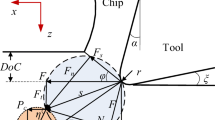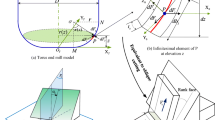Abstract
The machining residual stress generated on the surface of the machined parts during machining has a crucial influence on the machining accuracy, fatigue strength, and corrosion resistance of the parts. Tool wear will aggravate the tool-work friction, and the thermal and mechanical load will change significantly, affecting the residual stress distribution. The distribution of 3D oblique cutting mechanical stress and thermal stress during tool wear is predicted by analyzing the 3D contact state of quick oblique cutting. The incremental thermal-elastic–plastic method is used for stress loading, and the 3D relaxation method is used for stress release to obtain residual stress. An analytical residual stress model considering tool wear is proposed to predict the residual stress distribution in milling, while aluminum alloy 7075-T6 is used as the workpiece in the case study. The results show that with the increase of tool wear, the residual stress of machined surface transfers from compressive stress to tensile stress, the value of sub-surface residual compressive stress increases the peak value of compressive stress moves more resounding, and the thickness of residual stress layer increases significantly. The average error between the predicted and experimental values is about 23.3%, which proves the model’s validity and provides a new idea for controlling the distribution of machining residual stress.















Similar content being viewed by others
Data availability
The datasets used or analyzed during the current study are available from the corresponding author on reasonable request.
Code availability
Not applicable.
References
Wan M, Ye XY, Wen DY, Zhang WH (2019) Modeling of machining-induced residual stresses. J Mater Sci 54(1):1–35
Wu Q, Xie DJ, Si Y, Zhang YD, Li L, Zhao YX (2018) Simulation analysis and experimental study of milling surface residual stress of Ti-10V-2Fe-3Al. J Manuf Process 32:530–537
Ulutan D, Ozel T (2011) Machining induced surface integrity in titanium and nickel alloys: a review. Int J Mach Tools Manuf 51(3):250–280
Liu CR, Barash MM (1982) Variables governing patterns of mechanical residual stress in a machined surface. J Manuf Sci Eng 104(3):257–264
Liu HW, Zheng JX, Guo YL, Zhu LX (2020) Residual stresses in high-speed two-dimensional ultrasonic rolling 7050 aluminum alloy with thermal-mechanical coupling. Int J Mech Sci 186:105824
Jiang XH, Kong XJ, He S, Wu K (2021) Modeling the superposition of residual stresses induced by cutting force and heat during the milling of thin-walled parts. J Manuf Process 68:356–370
Liu CR, Barash MM (1976) The mechanical state of the sublayer of a surface generated by chip-removal process—Part 1: Cutting with a sharp tool. J Manuf Sci Eng 98(4):1192–1199
Liang SY, Su JC (2007) Residual stress modeling in orthogonal machining. CIRP Ann 56(1):65–68
Yue CX, Hao XL, Ji X, Liu XL, Liang SY, Wang LH, Yan F (2020) Analytical prediction of residual stress in the machined surface during milling. Metals 10(4):498
McDowell DL (1997) An approximate algorithm for elastic-plastic two-dimensional rolling/sliding contact. Wear 211(2):237–246
Lazoglu I, Ulutan D, Alaca BE, Engin S, Kaftanoglu B (2008) An enhanced analytical model for residual stress prediction in machining. CIRP Ann 57(1):81–84
Agrawal S, Joshi SS (2013) Analytical modelling of residual stresses in orthogonal machining of AISI4340 steel. J Manuf Process 15(1):167–179
Yang D, Liu ZQ, Ren XP, Zhuang P (2016) Hybrid modeling with finite element and statistical methods for residual stress prediction in peripheral milling of titanium alloy Ti-6Al-4V. Int J Mech Sci 108:29–38
Su JC, Young KA, Ma K, Srivatsa S, Morehouse JB, Liang SY (2013) Modeling of residual stresses in milling. Int J Adv Manuf Technol 65(5):717–733
Huang XD, Zhang XM, Ding H (2015) An analytical model of residual stress for flank milling of Ti-6Al-4V. Procedia Cirp 31:287–292
Wang SQ, Li JG, He CL, Xie ZY (2019) A 3D analytical model for residual stress in flank milling process. Int J Adv Manuf Technol 104(9):3545–3565
Wan M, Ye XY, Yang Y, Zhang WH (2017) Theoretical prediction of machining-induced residual stresses in three-dimensional oblique milling processes. Int J Mech Sci 133:426–437
Liu M, Takagi JI, Tsukuda A (2004) Effect of tool nose radius and tool wear on residual stress distribution in hard turning of bearing steel. J Mater Process Technol 150(3):234–241
Chen L, El-Wardany TI, Harris WC (2004) Modelling the effects of flank wear land and chip formation on residual stresses. CIRP Ann 53(1):95–98
Madariaga A, Kortabarria A, Hormaetxe E, Garay A, Arrazola PJ (2016) Influence of tool wear on residual stresses when turning Inconel 718. Procedia CIRP 45:267–270
Niaki FA, Mears L (2017) A comprehensive study on the effects of tool wear on surface roughness, dimensional integrity and residual stress in turning IN718 hard-to-machine alloy. J Manuf Process 30:268–280
Yan L, Yang WY, Jin HP, Wang ZG (2012) Analytical modeling of the effect of the tool flank wear width on the residual stress distribution. Mach Sci Technol 16(2):265–286
Liang XL, Liu ZQ, Wang B, Song QH, Cai YK, Wan Y (2021) Prediction of residual stress with multi-physics model for orthogonal cutting Ti-6Al-4V under various tool wear morphologies. J Mater Process Technol 288:116908
Merchant ME (1945) Mechanics of the metal cutting process. I. Orthogonal cutting and a type 2 chip. J Appl Phys 16(5):267–275
Shamoto E, Altıntas Y (1999) Prediction of shear angle in oblique cutting with maximum shear stress and minimum energy principles. J Manuf Sci Eng 121(3):399–407
Li BL, Wang XL, Hu Y, Li CG (2011) Analytical prediction of cutting forces in orthogonal cutting using unequal division shear-zone model. Int J Adv Manuf Technol 54(5):431–443
Waldorf DJ, DeVor RE, Kapoor SG (1998) A slip-line field for ploughing during orthogonal cutting. J Manuf Sci Eng 120(4):693–699
Huang Y, Liang SY (2003) Modelling of the cutting temperature distribution under the tool flank wear effect. Proc Inst Mech Eng C J Mech Eng Sci 217(11):1195-1208
Huang K, Yang WY (2016) Analytical modeling of residual stress formation in workpiece material due to cutting. Int J Mech Sci 114:21–34
Saif MTA, Hui CY, Zehnder AT (1993) Interface shear stresses induced by non-uniform heating of a film on a substrate. Thin Solid Films 224(2):159–167
Sun C, Xiu SC, Hong Y, Kong XN, Lu Y (2020) Prediction on residual stress with mechanical-thermal and transformation coupled in DGH. Int J Mech Sci 179:105629
Duan ZJ, Li CH, Ding WF, Zhang YB, Yang M, Gao T, Cao HJ, Xu XF, Wang DZ, Mao C, Li HN, Kumar GM, Said Z, Debnath S, Jamil M, Ali HM (2021) Milling force model for aviation aluminum alloy: academic insight and perspective analysis. Chin J Mech Eng 34(1):1–35
Funding
This work was supported by National Natural Science Foundation of China, (Grant No.52175393).
Author information
Authors and Affiliations
Contributions
Junhui Lu: methodology, investigation, experiments, writing—original draft, writing—review and editing, visualization; Caixu Yue: project administration, investigation, conceptualization, supervision; Zhitao Chen: conceptualization, supervision; Xianli Liu: project administration, validation, supervision; Ming Li: supervision, Validation; Steven Y. Liang: writing—review and editing, supervision, validation.
Corresponding author
Ethics declarations
Ethics approval
The content studied in this article belongs to the field of metal processing, does not involve humans and animals. This article strictly follows the accepted principles of ethical and professional conduct.
Consent to participate
My co-authors and I would like to opt in to In Review.
Consent for publication
I agree with the Copyright Transfer Statement.
Conflict of interest
The authors declare no competing interests.
Additional information
Publisher's note
Springer Nature remains neutral with regard to jurisdictional claims in published maps and institutional affiliations.
Rights and permissions
Springer Nature or its licensor (e.g. a society or other partner) holds exclusive rights to this article under a publishing agreement with the author(s) or other rightsholder(s); author self-archiving of the accepted manuscript version of this article is solely governed by the terms of such publishing agreement and applicable law.
About this article
Cite this article
Lu, J., Yue, C., Chen, Z. et al. Analytical modeling of milling residual stress under different tool wear conditions. Int J Adv Manuf Technol 127, 4253–4269 (2023). https://doi.org/10.1007/s00170-023-11715-4
Received:
Accepted:
Published:
Issue Date:
DOI: https://doi.org/10.1007/s00170-023-11715-4




